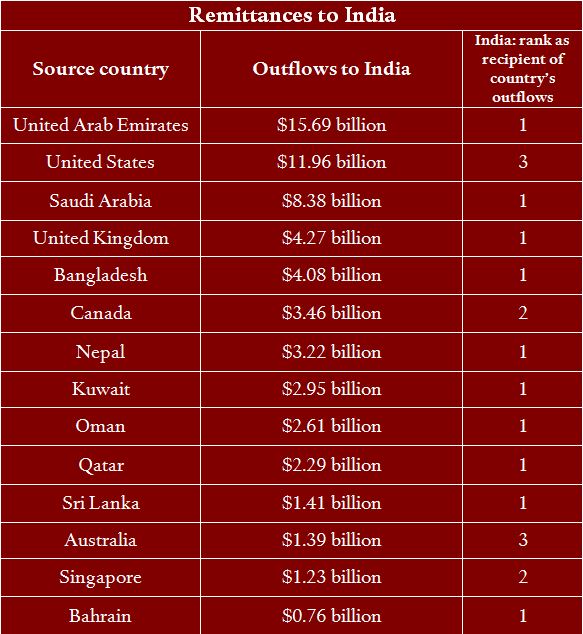India’s Stakes in the Middle East

More on:
The Pew Research Center just released a superb infographic drawing on World Bank remittance data that makes it possible, with just a few clicks, to instantly see how remittances flow from source to recipient countries. It might not be a surprise to anyone that the United States is the number one source country, with more than $123 billion in remittances flowing to countries all over the world in 2012, the most recently available year. And it might not be a surprise, either, to learn that India is the number one recipient country, with $69 billion coming in during 2012. But how many people would guess that even though the United States is the number one source country for outflows worldwide, it isn’t the largest source of remittances going to India. That would be the United Arab Emirates (UAE). More than $15 billion was remitted to India from the UAE during 2012, compared with $11 billion from the United States.
Clicking through the source countries for inflows to India reveals the importance of the Middle East to India. It turns out that remittances from the Gulf countries account for more than $30 billion, nearly half the 2012 total of $69 billion flowing to India. In addition to the UAE, source countries include Saudi Arabia ($8 billion), Kuwait (almost $3 billion), Oman ($2.6 billion), Qatar ($2.2 billion), and Bahrain ($760 million). Flows from the United Kingdom and Canada, by contrast, ranked below the UAE, United States, and Saudi Arabia. Pew Research’s interactive map is a great way to look at each of these; we compiled just the inbound India information, cross-referenced with source country, to pull together the scannable table here that also shows how India ranks as a destination for outflows. Estimates range from six to seven million Indian citizens working throughout the Middle East, providing substantial injections into the Indian economy, and helping their families and communities throughout their hard work abroad.

In the U.S. foreign policy imagination, India is not frequently seen as having direct interests in, or having larger strategic connections with the "greater middle east," but that optic overlooks important historical, social, and economic linkages. Kerala’s Syriac Christians trace their origins to St. Thomas, who arrived in Kerala in 52 CE. The first Muslims in India, predating the eighth century arrival in Sindh of Muhammad bin Qasim, were in Kerala, the result of maritime Indian Ocean trade with the Gulf during the seventh century. The scholar Sanjay Subrahmanyam has argued that Gujarat was a “linchpin” in commerce across the western Indian Ocean during the early modern era. Connectivity by sea, across the Indian Ocean Basin, reveals a history of deep trading linkages between India and the Gulf throughout early modern and modern history.
Even the rise of India’s paradigmatic entrepreneur, Dhirubhai Ambani, whose company Reliance has been estimated to account for around three percent of India’s gross domestic product, begins with time working in the Gulf in both Yemen and Dubai. The late eminent MIT scholar Myron Weiner did research in the 1980s examining nonresident Indians in the Gulf and the sociology of that particularly highly skilled diaspora. And this is just the people-to-people ties; India’s energy needs have led to extensive oil and gas relationships across the Middle East, with the Gulf the main source for India’s oil imports, accounting for 82 percent of its overall needs according to the Financial Times. So Indian links with the Gulf region have a deep history, and are the source of important and urgent economic impact.
Yet a fully described strategy for India’s foreign policy toward the Middle East, which India calls "West Asia," has not been articulated, unlike India’s "Look East" policy toward Asia, which dates back to 1992. Non-Alignment 2.0, the strategic doctrine released by an Indian think tank in 2012, makes just this point (page 16), urging that India’s economic security interests must be better safeguarded through more active Indian diplomacy in the Middle East. Non-Alignment 2.0 also cautioned that the forces unleashed through Arab Spring movements would make for instability, and difficult choices for Indian foreign policy on questions like humanitarian intervention and its effects. Two years on, strategic thinker C. Raja Mohan reiterated the call for India to focus on its Middle Eastern interests, advocating the need for a coherent "Look West" foreign policy to complement its eastern gaze, and offering concrete steps the next Indian government should take to elevate its relationships across the region. Indeed, just this week the Indian government hosts visits of the Crown Prince of Saudi Arabia, as well as the Omani foreign minister.
With turbulence throughout the Middle East, and limited solutions for extremely challenging problems, a stronger voice from democratic, stable India could be a helpful influence. Apart from the diplomatic efforts of the India-Brazil-South Africa grouping to urge a political solution in Syria during 2011 and 2012 (a crisis which has proved irremediable to all appeals), India’s voice on the Middle East has not been loud amidst the fray. Let’s hope the “Look West” efforts come to fruition soon.
Follow me on Twitter: @AyresAlyssa
More on:
 Online Store
Online Store
